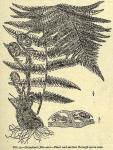 The dried rhizome of Dryop'teris fil'ix-mas Schott, and of Dryop'teris margina'lis Asa Gray (family Polypodiaceae). Collected in autumn, freed from the roots and dead portions of rhizome and stipes, and dried at a temperature not exceeding 70°C.
The dried rhizome of Dryop'teris fil'ix-mas Schott, and of Dryop'teris margina'lis Asa Gray (family Polypodiaceae). Collected in autumn, freed from the roots and dead portions of rhizome and stipes, and dried at a temperature not exceeding 70°C.
BOTANICAL CHARACTERISTICS.—Fruit-dots round, borne at the back of the veins; indusium covering the sporangia. Stipe continuous with the root-stock. Frond lanceolate (A. filix-mas) or ovate-oblong (A. marginalis); fruit-dots in the former nearer the mid-vein than the margin, in the latter nearer the margin.
HABITAT.—North America.
 DESCRIPTION OF DRUG.—As taken from the ground the rhizome consists of a caudex around which are arranged the dark brown, somewhat curved leaf-stalk remnants or stipes, about 25 to 50 mm. (1 to 2 in.) in length, imbricated like the shingles of a roof; at the base they are densely surrounded by thin, glossy, chaffy scales of a lighter color and somewhat transparent. The entire rhizome is from 100 to 300 mm. (4 to 12 in.) long, and from 50 to 62 mm. (2 to 2 ½ in.) thick, flexible, tapering toward one end, usually split longitudinally, roughly scarred with remains of stipe bases or bearing several coarse longitudinal ridges or grooves, pale green when fresh and becoming pale brown and with occasional elongated areas of the still adhering brownish-black outer layers, fracture short, pale green in the inner half, the texture rather spongy and exhibiting from 6 to 12 fibrovascular bundles in a loose and interrupted circle; it generally comes into market broken into pieces of various lengths; internally pale green, spongy or corky; odor slight and disagreeable; taste sweetish, somewhat bitter and astringent, acrid and nauseous. Only such portions as are still green should be used in making preparations. The deterioration of the root is rapid-loses its activity in one or two years.
DESCRIPTION OF DRUG.—As taken from the ground the rhizome consists of a caudex around which are arranged the dark brown, somewhat curved leaf-stalk remnants or stipes, about 25 to 50 mm. (1 to 2 in.) in length, imbricated like the shingles of a roof; at the base they are densely surrounded by thin, glossy, chaffy scales of a lighter color and somewhat transparent. The entire rhizome is from 100 to 300 mm. (4 to 12 in.) long, and from 50 to 62 mm. (2 to 2 ½ in.) thick, flexible, tapering toward one end, usually split longitudinally, roughly scarred with remains of stipe bases or bearing several coarse longitudinal ridges or grooves, pale green when fresh and becoming pale brown and with occasional elongated areas of the still adhering brownish-black outer layers, fracture short, pale green in the inner half, the texture rather spongy and exhibiting from 6 to 12 fibrovascular bundles in a loose and interrupted circle; it generally comes into market broken into pieces of various lengths; internally pale green, spongy or corky; odor slight and disagreeable; taste sweetish, somewhat bitter and astringent, acrid and nauseous. Only such portions as are still green should be used in making preparations. The deterioration of the root is rapid-loses its activity in one or two years.
MICROSCOPICAL STRUCTURE.—The prevailing tissue is parenchyma, the polyhedral, porous-walled cells of which contain starch, greenish or brownish tannin-like substances, and drops of a greenish fixed oil. The thin subserous outer layer consists of smaller brown cells. Toward the center of the rhizome is an irregular circle of ten (A. filixmas) or six (A. marginalis) vascular bundles, outside of which are smaller scattered bundles. Distributed throughout the tissue are large air pores.
Powder.—Microscopical elements of: See Part iv, Chap. I, B.
CONSTITUENTS.—Filicic acid, C35H42O13, filicin (filicic acid anhydrid, C31H40O12), aspidin, C23H27O7, the latter being poisonous, fixed oil, a trace of volatile oil, and chlorophyll. Ash 3 per cent.
Preparation of Filicic Acid.—This principle is deposited as a granular sediment when the oleoresin is allowed to stand.
ACTION AND USES.—Taeniafuge. Dose: ½ to 2 dr. (2 to 8 Gm.). The oleoresin is the most efficient preparation.
- OFFICIAL PREPARATION.
- Oleoresina Aspidii, Dose: ½ to 1 fl. dr. (2 to 4 mils)

